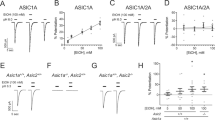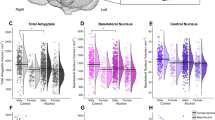Abstract
Alcohol seeking during abstinence is mediated in part by strong associations between the pharmacological effects of alcohol and the environment within which alcohol is administered. The amygdala, particularly the basolateral amygdala (BLA), is a key neural substrate of environmental cue and reward associations since it is involved in associative learning and memory recall. However, we still lack a clear understanding of how alcohol affects the activity of BLA neurons, which may encode information that drives environmental cue-dependent, alcohol-related behaviors. We previously demonstrated that a subset of BLA neurons which express the calcium/calmodulin-dependent protein kinase II (CaMKII) and thymus cell antigen 1 (Thy1) markers project preferentially to the nucleus accumbens (NAcc), rather than the central amygdala; and these neurons mediate fear inhibition rather than fear acquisition or expression, suggesting a specific role in positive valence processing. We now demonstrate that Pavlovian conditioning with alcohol administration increases the activity of these Thy1-expressing (Thy1+) excitatory neurons in mouse BLA, which is necessary for the conditioned appetitive response. In vivo calcium imaging indicates that the temporal activity profile of these neurons is also correlated with alcohol-induced motivated behavior in response to environmental cues. Optogenetic inhibition of BLA Thy1+ neuronal activity at cell body disrupts both the formation and expression of alcohol-induced conditioned place preference. Furthermore, selective axonal inhibition of BLA-Thy1+ efferents reveals that the activity of their NAcc and prefrontal cortex (PFC) projections are differentially necessary for alcohol cue association vs. recall, respectively. Together, these findings provide insights into a molecularly distinct subset of BLA neurons that regulates environmental cue-reward associations and drives alcohol-induced motivated behaviors in a projection-specific manner.
This is a preview of subscription content, access via your institution
Access options
Subscribe to this journal
Receive 12 print issues and online access
$259.00 per year
only $21.58 per issue
Buy this article
- Purchase on SpringerLink
- Instant access to full article PDF
Prices may be subject to local taxes which are calculated during checkout





Similar content being viewed by others
Data availability
The datasets used and analyzed during the current study are available from the corresponding author on reasonable request.
References
Hasin DS, Stinson FS, Ogburn E, Grant BF. Prevalence, correlates, disability, and comorbidity of DSM-IV alcohol abuse and dependence in the United States: results from the National Epidemiologic Survey on Alcohol and Related Conditions. Arch Gen Psychiatry. 2007;64:830–42.
Rehm J, Mathers C, Popova S, Thavorncharoensap M, Teerawattananon Y, Patra J. Global burden of disease and injury and economic cost attributable to alcohol use and alcohol-use disorders. Lancet. 2009;373:2223–33.
Robinson TE, Berridge KC. The neural basis of drug craving: an incentive-sensitization theory of addiction. Brain Res Brain Res Rev. 1993;18:247–91.
Hyman SE. Addiction: a disease of learning and memory. Am J Psychiatry. 2005;162:1414–22.
Heinz A, Beck A, Grusser SM, Grace AA, Wrase J. Identifying the neural circuitry of alcohol craving and relapse vulnerability. Addict Biol. 2009;14:108–18.
Wiers CE, Stelzel C, Gladwin TE, Park SQ, Pawelczack S, Gawron CK, et al. Effects of cognitive bias modification training on neural alcohol cue reactivity in alcohol dependence. Am J Psychiatry. 2015;172:335–43.
Koob GF, Le Moal M. Drug addiction, dysregulation of reward, and allostasis. Neuropsychopharmacology. 2001;24:97–129.
Suh J, Ressler KJ. Common biological mechanisms of alcohol use disorder and post-traumatic stress disorder. Alcohol Res. 2018;39:131–45.
Crombag HS, Bossert JM, Koya E, Shaham Y. Review. Context-induced relapse to drug seeking: a review. Philos Trans R Soc Lond B Biol Sci. 2008;363:3233–43.
Fenster RJ, McCullough K, Naumenko S, Thompson A, Klengel C, Rodgers A, et al. Cell-type specific induction of cyclo-oxygenase-2 in layer II/III prefrontal cortical neurons mediates stress-induced anxiety phenotypes in mice. bioRxiv 2021.2010.2010.463815 [Preprint]. 2021 https://www.biorxiv.org/content/10.1101/2021.10.10.463815v1.
Claus ED, Ewing SW, Filbey FM, Sabbineni A, Hutchison KE. Identifying neurobiological phenotypes associated with alcohol use disorder severity. Neuropsychopharmacology. 2011;36:2086–96.
Hill KG, Ryabinin AE, Cunningham CL. FOS expression induced by an ethanol-paired conditioned stimulus. Pharmacol Biochem Behav. 2007;87:208–21.
Dayas CV, Liu X, Simms JA, Weiss F. Distinct patterns of neural activation associated with ethanol seeking: effects of naltrexone. Biol Psychiatry. 2007;61:979–89.
Chaudhri N, Woods CA, Sahuque LL, Gill TM, Janak PH. Unilateral inactivation of the basolateral amygdala attenuates context-induced renewal of Pavlovian-conditioned alcohol-seeking. Eur J Neurosci. 2013;38:2751–61.
Herry C, Ciocchi S, Senn V, Demmou L, Muller C, Luthi A. Switching on and off fear by distinct neuronal circuits. Nature. 2008;454:600–6.
Kim J, Pignatelli M, Xu S, Itohara S, Tonegawa S. Antagonistic negative and positive neurons of the basolateral amygdala. Nat Neurosci. 2016;19:1636–46.
Namburi P, Beyeler A, Yorozu S, Calhoon GG, Halbert SA, Wichmann R, et al. A circuit mechanism for differentiating positive and negative associations. Nature. 2015;520:675–8.
Zhang X, Guan W, Yang T, Furlan A, Xiao X, Yu K, et al. Genetically identified amygdala-striatal circuits for valence-specific behaviors. Nat Neurosci. 2021;24:1586–600.
Feng G, Mellor RH, Bernstein M, Keller-Peck C, Nguyen QT, Wallace M, et al. Imaging neuronal subsets in transgenic mice expressing multiple spectral variants of GFP. Neuron. 2000;28:41–51.
McCullough KM, Choi D, Guo J, Zimmerman K, Walton J, Rainnie DG, et al. Molecular characterization of Thy1 expressing fear-inhibiting neurons within the basolateral amygdala. Nat Commun. 2016;7:13149.
Jasnow AM, Ehrlich DE, Choi DC, Dabrowska J, Bowers ME, McCullough KM, et al. Thy1-expressing neurons in the basolateral amygdala may mediate fear inhibition. J Neurosci. 2013;33:10396–404.
Cunningham CL, Gremel CM, Groblewski PA. Drug-induced conditioned place preference and aversion in mice. Nat Protoc. 2006;1:1662–70.
Cunningham CL, Shields CN. Effects of multi-modal cues on conditioned place preference in C57BL/6J and DBA/2J mice. Psychopharmacology (Berl). 2018;235:3535–43.
O’Neal TJ, Bernstein MX, MacDougall DJ, Ferguson SM. A conditioned place preference for heroin is signaled by increased dopamine and direct pathway activity and decreased indirect pathway activity in the nucleus accumbens. J Neurosci. 2022;42:2011–24.
Janak PH, Tye KM. From circuits to behaviour in the amygdala. Nature. 2015;517:284–92.
Beyeler A, Namburi P, Glober GF, Simonnet C, Calhoon GG, Conyers GF, et al. Divergent routing of positive and negative information from the amygdala during memory retrieval. Neuron. 2016;90:348–61.
Ambroggi F, Ishikawa A, Fields HL, Nicola SM. Basolateral amygdala neurons facilitate reward-seeking behavior by exciting nucleus accumbens neurons. Neuron. 2008;59:648–61.
Stuber GD, Sparta DR, Stamatakis AM, van Leeuwen WA, Hardjoprajitno JE, Cho S, et al. Excitatory transmission from the amygdala to nucleus accumbens facilitates reward seeking. Nature. 2011;475:377–80.
Meinhardt MW, Hansson AC, Perreau-Lenz S, Bauder-Wenz C, Stahlin O, Heilig M, et al. Rescue of infralimbic mGluR2 deficit restores control over drug-seeking behavior in alcohol dependence. J Neurosci. 2013;33:2794–806.
Kroener S, Mulholland PJ, New NN, Gass JT, Becker HC, Chandler LJ. Chronic alcohol exposure alters behavioral and synaptic plasticity of the rodent prefrontal cortex. PLoS One. 2012;7:e37541.
Renteria R, Baltz ET, Gremel CM. Chronic alcohol exposure disrupts top-down control over basal ganglia action selection to produce habits. Nat Commun. 2018;9:211.
Gass JT, Sinclair CM, Cleva RM, Widholm JJ, Olive MF. Alcohol-seeking behavior is associated with increased glutamate transmission in basolateral amygdala and nucleus accumbens as measured by glutamate-oxidase-coated biosensors. Addict Biol. 2011;16:215–28.
Fenster RJ, Lebois LAM, Ressler KJ, Suh J. Brain circuit dysfunction in post-traumatic stress disorder: from mouse to man. Nat Rev Neurosci. 2018;19:535–51.
Liu X, Ramirez S, Redondo RL, Tonegawa S. Identification and manipulation of memory engram cells. Cold Spring Harb Symp Quant Biol. 2014;79:59–65.
Redondo RL, Kim J, Arons AL, Ramirez S, Liu X, Tonegawa S. Bidirectional switch of the valence associated with a hippocampal contextual memory engram. Nature. 2014;513:426–30.
Gal E, Amsalem O, Schindel A, London M, Schurmann F, Markram H, et al. The role of hub neurons in modulating cortical dynamics. Front Neural Circuits. 2021;15:718270.
Shinonaga Y, Takada M, Mizuno N. Topographic organization of collateral projections from the basolateral amygdaloid nucleus to both the prefrontal cortex and nucleus accumbens in the rat. Neuroscience. 1994;58:389–97.
Huang L, Chen Y, Jin S, Lin L, Duan S, Si K, et al. Organizational principles of amygdalar input-output neuronal circuits. Mol Psychiatry. 2021;26:7118–29.
Cunningham CL, Shields CN. Effects of sex on ethanol conditioned place preference, activity and variability in C57BL/6J and DBA/2J mice. Pharmacol Biochem Behav. 2018;173:84–9.
Morris R. Thy-1 in developing nervous tissue. Dev Neurosci. 1985;7:133–60.
Barlow JZ, Huntley GW. Developmentally regulated expression of Thy-1 in structures of the mouse sensory-motor system. J Comp Neurol. 2000;421:215–33.
Narendra S, Klengel C, Hamzeh B, Patel D, Otten J, Lardenoije R, et al. Genome-wide transcriptomics of the amygdala reveals similar oligodendrocyte-related responses to acute and chronic alcohol drinking in female mice. Transl Psychiatry. 2022;12:476.
Trouche S, Koren V, Doig NM, Ellender TJ, El-Gaby M, Lopes-Dos-Santos V, et al. A hippocampus-accumbens tripartite neuronal motif guides appetitive memory in space. Cell. 2019;176:1393–406 e1316.
Bruno CA, O’Brien C, Bryant S, Mejaes JI, Estrin DJ, Pizzano C, et al. pMAT: An open-source software suite for the analysis of fiber photometry data. Pharmacol Biochem Behav. 2021;201:173093.
Calipari ES, Bagot RC, Purushothaman I, Davidson TJ, Yorgason JT, Pena CJ, et al. In vivo imaging identifies temporal signature of D1 and D2 medium spiny neurons in cocaine reward. Proc Natl Acad Sci USA. 2016;113:2726–31.
Acknowledgements
This work was supported by NIH awards R21-AA027450 (JS and KR), R01-AA030585 (JS), P50-MH115874 (KJR), R01-MH108665 (KJR), and the Frazier Institute at McLean Hospital (KJR).
Author information
Authors and Affiliations
Contributions
Participated in research design: JS, KJR. Conducted experiments: JS, QCFB, ALP, MAZ. Performed data analysis: JS, BKM. Wrote or contributed to the writing of the manuscript: JS, KJR.
Corresponding authors
Ethics declarations
Competing interests
The authors declare no competing interests. KJR has received consulting income from Acer, Bionomics, and Jazz Pharma; serves on Scientific Advisory Boards for Sage, Boehringer Ingelheim, Senseye, the Brain and Behavior Research Foundation, and the Brain Research Foundation, and he has received sponsored research support from Alto Neuroscience. None of this work is directly related to the work presented here.
Ethics Approval
All the methods in the current study were approved by McLean Hospital’s Institutional Animal Care and Use Committee (#2018N000123) and maintained adherence to the National Research Council’s Guide for the Care and Use of Laboratory Animals.
Additional information
Publisher’s note Springer Nature remains neutral with regard to jurisdictional claims in published maps and institutional affiliations.
Rights and permissions
Springer Nature or its licensor (e.g. a society or other partner) holds exclusive rights to this article under a publishing agreement with the author(s) or other rightsholder(s); author self-archiving of the accepted manuscript version of this article is solely governed by the terms of such publishing agreement and applicable law.
About this article
Cite this article
Suh, J., Flanagan-Burt, Q.C., Moon, B.K. et al. Projection-specific roles of basolateral amygdala Thy1 neurons in alcohol-induced place preference. Mol Psychiatry (2025). https://doi.org/10.1038/s41380-025-03184-w
Received:
Revised:
Accepted:
Published:
DOI: https://doi.org/10.1038/s41380-025-03184-w



